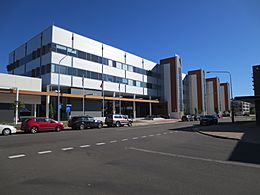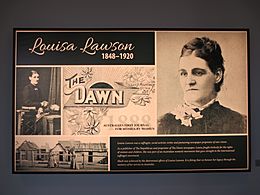Louisa Lawson facts for kids
Quick facts for kids
Louisa Lawson
|
|
|---|---|

Portrait of Louisa Lawson
|
|
| Born |
Louisa Albury
February 17, 1848 Gulgong, New South Wales, Australia
|
| Died | 12 August 1920 (aged 72) Gladesville, New South Wales, Australia
|
| Resting place | Rookwood Cemetery |
| Education | Mudgee National School |
| Spouse(s) | Peter Lawson né Niels Larsen |
| Children | Henry Lawson and 4 others |
Louisa Lawson (born Albury) was an amazing Australian woman. She was a poet, writer, and publisher. She also fought for women's rights, especially for women to vote. Louisa was the mother of a famous Australian poet, Henry Lawson.
Contents
Louisa Lawson's Early Life
Louisa Albury was born on February 17, 1848. Her family lived near Gulgong, New South Wales, in Australia. She was one of 12 children. Like many girls back then, she left school when she was 13 years old.
In 1866, when she was 18, Louisa married Niels Larsen. He was a sailor from Norway. Niels often went away to look for gold or work. This meant Louisa was often left alone to raise their four children.
In 1882, Louisa and her children moved to Sydney. There, she managed places where people could rent rooms, called boarding houses. This helped her save money for her future plans.
A Pioneer Publisher
Louisa Lawson used the money she saved from her boarding houses. In 1887, she bought shares in a newspaper called The Republican. This newspaper supported the idea of Australia becoming its own country. Louisa and her son Henry worked together on The Republican. They printed it in Louisa's small cottage.
The Republican wanted Australia to become a republic. It dreamed of a "Great Republic of the Southern Seas." After The Republican, Louisa started another paper called The Nationalist, but it only lasted for two issues.
Starting The Dawn
With her earnings and experience, Louisa started her own magazine in May 1888. It was called The Dawn. This was very special because it was Australia's first magazine made only by women. It was sent all over Australia and even overseas.
The Dawn focused on women's rights. It talked about women being able to vote and hold public jobs. It also discussed women's education and their rights to own property. The magazine was published every month for 17 years, from 1888 to 1905. At its busiest, it employed 10 women. Louisa's son Henry also wrote poems and stories for The Dawn. In 1894, The Dawn press even printed Henry's first book.
In 1904, Louisa published her own story called Dert and Do. The next year, she put together her poems into a book called The Lonely Crossing and other Poems. Louisa had a big impact on her son's writing when he was starting out.
Fighting for Women's Rights
In 1889, Louisa Lawson started The Dawn Club. This club became a very important place for the movement to get women the right to vote in Sydney. In 1891, the Womanhood Suffrage League of New South Wales was formed. This group worked hard to get women the vote. Louisa let them use her Dawn office to print their leaflets and other materials for free.
When women in New South Wales finally got the right to vote in 1902, Louisa was honored. She was introduced to the members of Parliament as "The Mother of Suffrage in New South Wales." This shows how important she was in helping women gain this basic right.
Later Life and Legacy
Louisa Lawson stopped working in 1905. But she kept writing for magazines in Sydney. She also published her book of poems, The Lonely Crossing and Other Poems, which had 53 poems.
She passed away on August 12, 1920, at the age of 72. She had been ill for a long time. Louisa was buried with her parents in Rookwood Cemetery.
Memorials
Louisa Lawson is remembered in many ways. In 1941, a special seat was placed in The Domain, Sydney, to honor her.
In 1975, Australia Post released a stamp with Louisa's picture on it. This stamp was part of a series celebrating the International Year of Women.
There is also a park named after her in Marrickville, New South Wales. The Louisa Lawson Reserve has a colorful picture made of small stones. It shows the front cover of The Dawn. A plaque there says the stones are from her old home.
Two places in Canberra, Australia's capital, are also named after her: Louisa Lawson Crescent in Gilmore and the Louisa Lawson Building in Greenway. The building is used by Services Australia.
Selected Poems
- "To a Bird" (1888)
- "A Dream" (1891)
- "A Birthday Wish" (1892)
- "To a Bird" (1892)
- "To My Sister" (1893)
- "Lines Written During a Night Spent in a Bush Inn" (1901)
- "The Digger's Daughter" (1903)
- "The Hour is Come" (1903)
- "Back Again" (1904)
- "In Memoriam" (1905)
- "A Child's Question" (1905)
- "A Mother's Answer" (1905)
See also
 In Spanish: Louisa Lawson para niños
In Spanish: Louisa Lawson para niños




